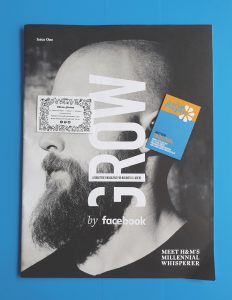
For most people, including those sitting in the boardrooms of the world’s leading media companies, the truth to the above question is that the answer remains a very large shrug.
The amount of disruption in every section of the media landscape has led us to the point where a lot is being said and a lot is being done, but no one truly has the answer – we continue to seek the ‘Holy Grail’.
Whichever way you look at it, there’s no single media platform that’s the ideal t for the millions of Australians that crave a regular stream of content.
Print, online, mobile, social, video, experiential, voice, etc. – the number of available channels has exploded in the past two decades, and brands, our customers, are still struggling to know how to use each channel, including the established and hard-working ones like print, to maximum effect.
However, we can take a few clues in a report published recently by magazine trade body FIPP and paper manufacturers UPM.
Handily titled The Future of Media, the report paints a picture of a media landscape that’s been turned upside-down by digital.
But where once the question on publishers’ lips was ‘print or digital?’, now it’s ‘what role does print play in the print, digital and experiential mix that allows us to maximise audience engagement, cross-selling and revenue generation?’.
Doesn’t trip off the tongue quite as easily, but it’s a far better assessment of the current situation.
Not all doom and gloom
The good news is that print remains at the heart of the business strategies of most major global publishing houses.
According to the report, between 60 to 80 per cent of publisher revenues are generated from print, with 58 per cent of subscribers describing themselves as primarily print-orientated.
In the US, the top 25 print magazines reach more people than the top 25 prime-time TV shows (Carat Insight, 2017), while in the UK, almost 25 million adults read news brands daily and 36 million read magazines every week (PAMCo, 2017).
The key to print’s enduring appeal is its simple and accessible nature, and its unrivalled ability to draw the reader in and absorb them completely in content that’s been commissioned, written, edited and designed by editorial experts – people who know a great story and how to keep you hooked until the very last word.
Compare that with a 140-character tweet or a brief online feature surrounded by ads specifically created to distract, and you can see why people are sticking with print for a deeper, more relaxing read.

“Print is a lean-back experience that gives the consumer a break from the intensity of the digital world,” Hearst Magazines president Troy Young said.
“It plays a really important role in saying, ‘This is important, this has a place in culture, so take a moment to read and think about this’.”
But while it’s clear that print remains popular and fulfils a key role in the lives of millions of people, for many publishers, the business model of a print-only magazine or customer profile magazine just isn’t sustainable.
New expectations
Consumers now expect to access content on a wide range of platforms, which all have to link up seamlessly to add layers of multi-media content to the original print work.
For Bauer Media, this network of complementary media driving revenue is called the 360 Model, where different channels, products and brand extensions revolve around the print product, engaging the core audience while bringing in new readers and enticing them to get closer to the brand.
“The best example of this is Motorcycle News,” explains Rob Munro-Hall, group managing director of Bauer Media. “That sells 60,000 copies a week as a newspaper, but also has a website that gets two million unique users. Then we also have a shop on the website, an insurance product, and four motorcycle shows, all under the same brand name.”
Another fascinating development is ‘reverse publishing’, where previously digital-only brands are using print to reach new and existing audiences, taking their online content and repurposing it in print.
From Amazon – with their Christmas toy catalogue – to Facebook’s Grow magazine, brands that have made billions from online media are now turning to print for its highly respected, trustworthy status.
Add LinkedIn and Google using direct mail to engage business audiences, Uber and Airbnb publishing their own print magazines to gain more marketing time with their customers, and Net-a-Porter and Asos launching publications to compete with the newsstand fashion titles, and you have a clear trend that adding more weight to the arguments for print media.

So, what is the future of media and what will print’s role be? How will we consume content in 10 or 20 years?
Frankly, your guess is as good as mine. Technology none of us can envisage could come along and make current content channels obsolete.
Consumer tastes and preferences may change entirely, driven by economic necessity, climate change or urban social movements. Artificial intelligence could even determine which content is appropriate for each person at any one time based on tranches of personal information held in vast datacentres.
But going on the current trends and developments of the past century, the one constant in all this change will be print.
Its unique ability to appeal to all the senses at once, along with the finely-honed craft that goes into making it and its strong environmental credentials, make it tough to beat for engagement, entertainment and the sheer enjoyment of reading. And, of course, I, like many Australians, love it.
Comment below to have your say on this story.
If you have a news story or tip-off, get in touch at editorial@sprinter.com.au.
Sign up to the Sprinter newsletter

